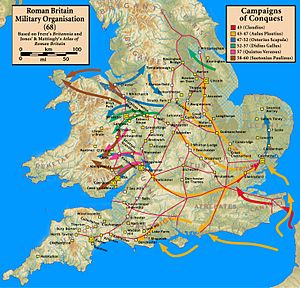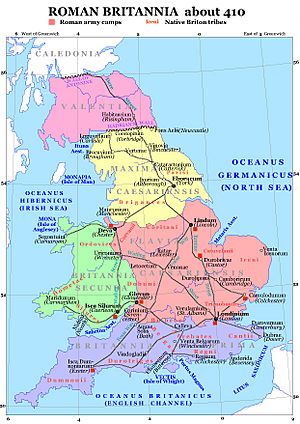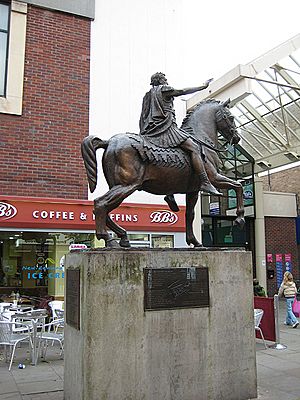Glevum facts for kids
Glevum was an important Roman fort in ancient Roman Britain. Later, it became a special Roman city called a "colonia" for soldiers who had retired. This happened in AD 97. Today, Glevum is known as Gloucester, a city in England. You can still find the name Glevum used by many local businesses. There is even a long walking path called the Glevum Way that goes around modern Gloucester.
Building a Roman Fort
Glevum was first built around AD 48. It was placed near a key crossing point of the River Severn. It was also close to the Fosse Way, an important Roman road. This road was like the front line during the early Roman invasion of Britain. The first Roman fort was set up at a place called Kingsholm around AD 65–70.
The Roman armies stationed here were likely the Legio XX Valeria Victrix. They stayed until AD 66. After that, the Legio II Augusta moved in. This legion used Glevum as a base to invade Roman Wales between AD 66 and 74.
Later, between AD 81 and 98, bigger walls were built. These new walls were on slightly higher ground. This area is now the center of Gloucester. This change was part of turning the military fort into a walled colonia. The Legio II Augusta had moved to Caerleon by then. A civilian town also grew outside the fort's walls.
Becoming a Roman City
In AD 97, the Roman Emperor Nerva gave Glevum a special title. It became a "colonia". A colonia was a city where retired legionaries (Roman soldiers) lived. These cities had the highest status in the Roman Empire. The retired soldiers were given farmland nearby. They could also be called upon to help as an armed force if needed.
The city of Glevum was built inside the old military fort. It kept the same straight street plan and strong walls. A large and impressive building called a basilica was built. This was used for administration. There was also a forum, which was a market-place. Many beautiful homes with mosaic floors were also built.
Glevum was likely the capital city of one of the four Roman provinces in Britain. This was probably Britannia Secunda. There is also some evidence that Glevum had its own mint. This means it could make its own coins.
Archaeologists have found the Roman wharf at Upper Quay Street. This was where goods were shipped using a small channel from the River Severn. Studies of the wood show it was built in AD 74. At its busiest time, Glevum might have had as many as 10,000 people living there.
The area around Glevum was very Romanized. This means Roman ways of life were common. Many Roman villas were built here in the second and third centuries. This was because the land was good for Roman farming methods. Today, some of the best examples of Roman villas in Britain are near Glevum. These include Chedworth villa and Woodchester villa. Both are famous for their beautiful Roman mosaics.
Decline of Glevum
Archaeological digs in Gloucester show that people continued to live in the town. This was even after the main Roman rule ended. The town's population might have become much smaller. A new gate was built in the town's wall in the early sixth century. This shows the town had some growth after the Battle of Mons Badonicus in 497.
The Anglo-Saxon Chronicle tells us about a King Coinmail. He might have been from Gloucester. He took part in the Battle of Dyrham in 577. This was when the city was taken over by the Anglo-Saxons.
What Remains Today
- You can see many Roman objects and some original walls from Glevum. They are on display at the Gloucester City Museum & Art Gallery.
- The remains of the Roman and medieval East Gate can be seen. They are in the East Gate Chamber on Eastgate Street.
- The main streets in Gloucester today follow the old Roman roads. These are Northgate, Southgate, Eastgate, and Westgate Streets.
- A statue of Emperor Nerva was put up in 2002. It stands at the entrance to Southgate Street. This statue was made by Anthony Stone. People raised money to pay for it. The campaign started in 1997, which was 1900 years after Glevum became a colonia.





